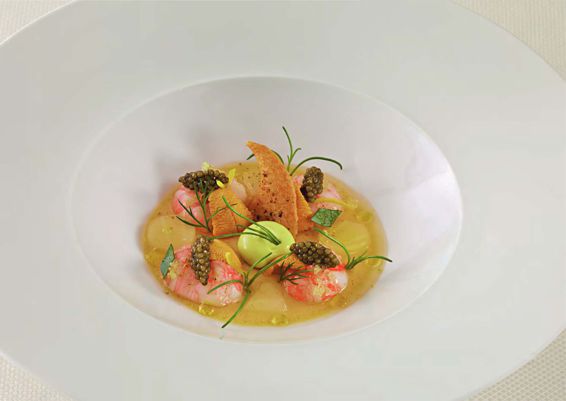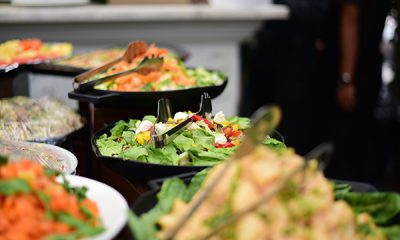Food Blogs
Langoustine And Uni Chaud-Froid Recipe
ONE OF MY FONDEST memories of vacationing on the Mediterranean is picking up sea urchins and eating them raw, accompanied by a nice and fresh Blanc de Provence. Once, near Menton, one of our sommeliers, Olivier Flosse, and his parents took me to an isolated creek to fish for urchins. Well, we almost got arrested because unbeknownst to us, the legal season for picking urchins had just ended!
This chaud-froid combines creamy sea urchin custard and a flavorful langoustine broth transformed into a gelée. The Scottish langoustines, the most refined saltwater shellfish, lacquered with more gelée, support plump grains of caviar. At the center of the plate, avocado espuma, a delicate mousse, acts as the vegetable coda.

| Servings |
MetricUS Imperial
|
Ingredients
Langoustine Broth
- 1 tablespoon sugar
- 1 tablespoons ½kosher salt
- 16 in live Scottish langoustines their shells
- tablespoon ½minced fresh ginger
- 1 ½ stalks lemongrass peeled and chopped
- teaspoon ½crushed Szechuan peppercorns
- teaspoon ½fennel seeds
- teaspoon ¼cracked black peppercorns
- teaspoon ¼coriander seeds
- Leaves of 2 sprigs tarragon chopped
Fennel Pollen Tuile
- Tuile Batter
- 1 teaspoon fennel pollen
Sea Urchin Custard
- 1 cup heavy cream
- 2 ounces ¾sea urchin roe
- 2 egg yolks
- teaspoon ¼salt
- teaspoon ¼lemon juice
- 1 splash of Tabasco sauce
- 1 pinch of piment d’Espelette
Glazed Langoustine Tails, Chayote, and Fennel
- Salt
- 1 small head fennel with stalks
- 1 small chayote
- 2 ½ sheets gelatin
- teaspoon ¼lemon juice
- Freshly ground white pepper if needed
- ounce ¼vegetable gelatin carrageenan
Avocado Espuma
- 1 ripe avocado
- 2 teaspoons Lemon juice
- teaspoon ¼xanthan gum
- Salt and freshly ground white pepper
To Finish
- 8 pieces sea urchin roe halved widthwise
- 2 tablespoons golden osetra caviar
- cup ¼fennel fronds reserved from above
- cup ¼sea cress leaves
- 8 oyster leaves cut into diamonds
- 16 Lemon Confit strips
- 1 teaspoon fennel pollen
- olive oil
- 2 finger limes
Instructions
For the Langoustine Broth
- In a large saucepan, combine 1 gallon of water with the sugar and 1 tablespoon of the salt; bring to a boil and place a bowl of ice water on the side. Twist and reserve the claws of the langoustines and discard the heads. Grasp the middle fin of the tails and gently twist and pull off to remove the veins. Boil the langoustine tails for 10 seconds, then immediately strain and transfer to the ice water to chill. Peel and discard the shells.
- Transfer half of the langoustine claws to the bowl of an electric mixer fitted with a paddle and begin to mix on low speed for 1 minute to break them into smaller chunks. Add the remaining claws and continue mixing for another minute, then increase the speed to medium and mix until they break down into a mash. Add the remaining ½ tablespoon salt, the ginger, lemongrass, Szechuan peppercorns, fennel seeds, black peppercorns, coriander seeds, and tarragon and mix until well combined. Transfer the mixture to a medium saucepan and cover with 1 quart water. Gently stir a few times, then place over medium heat. Bring to a gentle simmer, undisturbed, allowing the mixture to form a solid mass, or raft. Once the raft begins to rise to the surface, gently poke a hole in the top. Continue to gently simmer for 20 minutes, occasionally basting the raft by ladling broth from the hole. Carefully strain the liquid by ladling through a fine-meshed sieve lined with 3 layers of wet cheesecloth. Reserve the liquid, chilled.
For the Fennel Pollen Tuile
- Preheat the oven to 300°F. Line a baking sheet with a Silpat and, using a 1½-inch-wide teardrop-shaped stencil and a small offset spatula, spread the batter onto the sheet to make at least 4 tuiles. Sprinkle lightly with the fennel pollen and bake for 8 minutes, or until golden brown. Cool, then store in an airtight container at room temperature.
For the Sea Urchin Custard
- Preheat the oven to 200°F. Combine all the ingredients in a blender, puree just until smooth, and pass the mixture through a fine-meshed sieve into a bowl. Divide into 4 serving bowls with a 4-inch inset diameter to form ¼-inch-thick layers. Cover the bowls with plastic wrap and set inside a large roasting pan. Pour hot water into the roasting pan around the bowls to reach the level of the custard. Bake for 20 minutes, or until the custard is set. Remove the bowls from the water and rest for 15 minutes at room temperature. Unwrap and refrigerate until chilled, making sure to keep the bowls flat.
For the Glazed Langoustine Tails, Chayote, and Fennel
- Bring a large pot of salted water to a boil and place a bowl of ice water on the side. Trim the fennel, pick and reserve ¼ cup of the fronds, separate the layers of the bulb, and peel the outer sides of the layers. Using a ¾-inch-diameter ring cutter, punch out at least 8 “coins.” Peel the chayote and cut into ¼-inch slices. Cut at least eight ½-inch triangles from the slices. Boil the fennel and chayote in separate batches until tender, then transfer to the ice water to chill. Strain and pat dry with paper towels.
- Soak the gelatin sheets in ice water for 10 minutes, then squeeze dry. Pour the langoustine broth into a large saucepan and heat it to 135°F. Season the broth with the lemon juice and, if needed, salt and pepper. Submerge the langoustine tails in the broth and gently poach for 5 minutes, or until just cooked through. Pour the broth with the langoustines into a large bowl set over ice and stir until well chilled. Strain the broth through a fine-meshed sieve lined with cheesecloth and adjust the seasoning with salt and pepper if needed.
- Pour 1 cup of the broth into a small saucepan (reserving the remaining), place over medium heat, and whisk in the vegetable gelatin. Bring to a simmer, while whisking, for 30 seconds, then remove from the heat and cool to 95°F. Individually dip four langoustine tails into the cooled broth and arrange on a bowl of custard. Dip 2 fennel coins and 2 chayote triangles into the gelée and set on the custard, alternating in between the langoustines. Repeat the process with the remaining 3 bowls of custard. Return the bowls to the refrigerator and chill for 15 minutes, or until set.
- Pour 1 cup of the remaining broth into a small saucepan, bring to a simmer, then remove from the heat and stir in the gelatin sheets until dissolved. Cool to room temperature and pour approximately 2 tablespoons onto each bowl to cover the custard in a thin layer. Return to the refrigerator to set the gelée, about 1 hour.
For the Avocado Espuma
- Pit the avocado and scoop the flesh into a blender with the remaining ingredients and 6 tablespoons cold water. Puree until smooth. Pass through a fine-meshed sieve and transfer to the canister of a whipped cream maker. Insert a nitrogen cartridge and reserve, chilled.
To Finish
- For each serving, place a piece of sea urchin roe next to each langoustine and place a small spoonful of caviar on top of each langoustine. Squeeze approximately 1 tablespoon of avocado espuma in the center of the bowl and lean a fennel pollen tuile next to it. Garnish the top of the custard with 2 fennel fronds, 4 sea cress leaves, 2 oyster leaf diamonds, and 4 lemon confit strips; sprinkle some fennel pollen over the top and drizzle with a few drops of olive oil. Halve the finger limes and squeeze about ¼ teaspoon of finger lime juice pellets over the top of the custard.




















